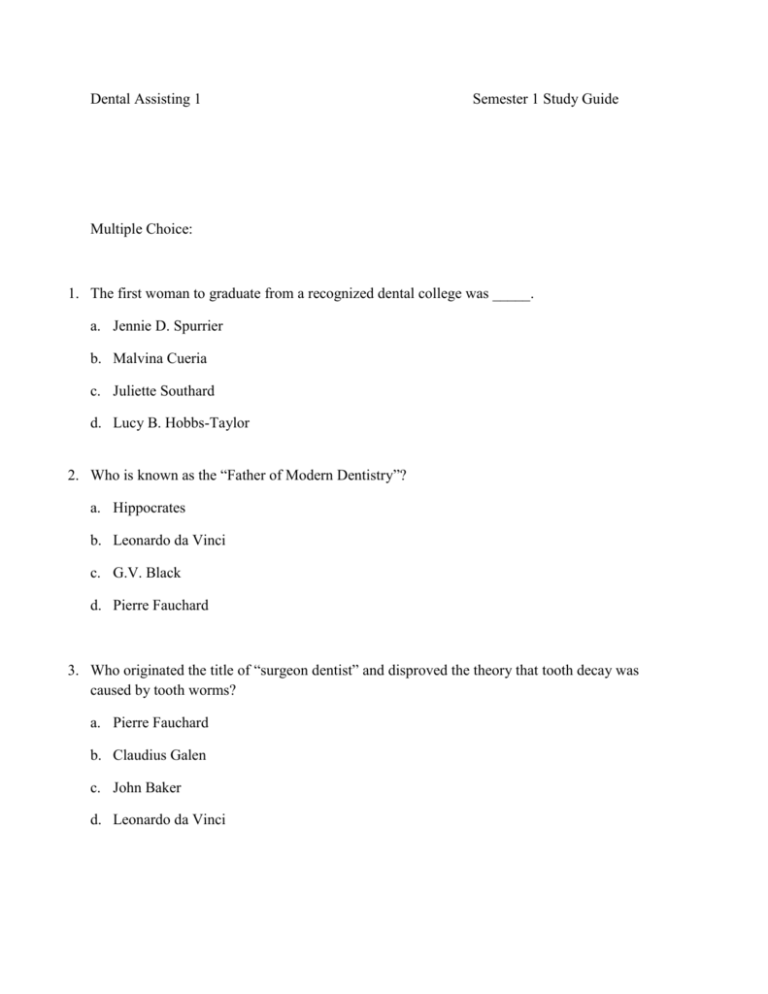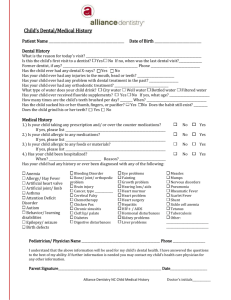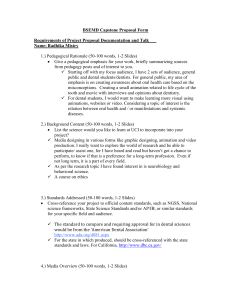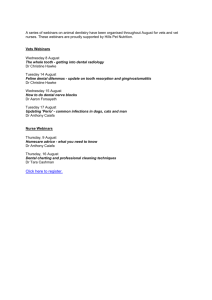Dental Assisting 1 Semester 1
advertisement

Dental Assisting 1 Semester 1 Study Guide Multiple Choice: 1. The first woman to graduate from a recognized dental college was _____. a. Jennie D. Spurrier b. Malvina Cueria c. Juliette Southard d. Lucy B. Hobbs-Taylor 2. Who is known as the “Father of Modern Dentistry”? a. Hippocrates b. Leonardo da Vinci c. G.V. Black d. Pierre Fauchard 3. Who originated the title of “surgeon dentist” and disproved the theory that tooth decay was caused by tooth worms? a. Pierre Fauchard b. Claudius Galen c. John Baker d. Leonardo da Vinci 4. Which early American dentist is credited with beginning the science of forensic dentistry? a. Robert Woofendale b. John Baker c. Paul Revere d. G.V. Black 5. The “Grand Old Man of Dentistry” was _____. a. Horace Hayden b. John Greenwood c. Horace Wells d. G.V. Black 6. The physicist who discovered x-rays in 1895 was _____. a. Paul Revere b. Wilhelm Conrad Roentgen c. G.V. Black d. Pierre Fauchard 7. What important medical discovery did Horace Wells make in 1844? a. inhalation anesthesia b. x-rays c. amalgam d. Novocain 8. Who was the first dentist to employ a dental assistant? a. Ida Gray-Rollins b. C. Edmund Kells c. G.V. Black d. Isaac Greenwood 9. The Commission on Dental Accreditation of the American Dental Association is responsible for a. writing dental curricula. b. licensing dentists. c. certifying dental school educators. d. evaluating and accrediting dental education programs. 10. The Dr. Samuel D. Harris National Museum of Dentistry is located in _____. a. Baltimore b. New York City c. Washington, D.C. d. 11. Philadelphia Which of the following statements is true concerning professionalism? a. It is what you do in the dental office, as distinguished from what you do on your own time. b. It is what you say in the dental office, as distinguished from what you say on your own time. c. It is an attitude apparent in everything you do and say, in and out of the dental office. d. It means you have a job. 12. The essential aspects of professional appearance are _____. a. long fingernails, clean uniform, and white shoes b. good health, good grooming, and appropriate dress c. appropriate dress, good hair cut, and clean skin d. scrubs, white shoes, and safety glasses 13. Recommendations for good grooming and appropriate dress include _____. a. using an up-to-date perfume or cologne as a form of aromatherapy b. limiting use of tobacco products to the outdoors to avoid an odor in treatment areas c. considering infection-control requirements when selecting clinical wear d. excessive makeup and jewelry, in order to distract patients from disagreeable aspects of their planned dental treatment 14. HIPAA laws regulate _____. a. infection control in the dental office b. discrimination in the treatment of HIV positive patients c. needle disposal d. patient privacy 15. Important personal qualities of the dental assistant include _____. a. maintaining a distance from the patient and not feeding into the patient’s needs b. being sincere c. discussing aspects of your personal life, to reduce distance and create empathy d. learning to be a good talker with a soothing voice, rather than a good listener 16. The organization that represents the dental assisting profession is _____. a. the American Dental Assistants Association b. the National Dental Assistant Society c. Dental Assistants United d. Dental Assistants of America 17. What agency issues the certified dental assistant (CDA) credential? a. the state dental board b. Dental Assisting National Board (DANB) c. American Dental Association (ADA) d. American Dental Assistants Association (ADAA) 18. How does a dental assistant become certified as a CDA? a. by passing the state boards b. by passing the national DANB exam c. by graduating from an accredited dental assisting program d. by working for two years in a dental office 19. Which of the following is considered to be the role of an expanded-functions dental assistant? a. mixing and passing dental materials b. pouring and trimming models c. placing dental sealants d. instituting infection-control procedures 20. Which of the following are members of the dental healthcare team? a. the dental assistant b. the dentist c. the dental supply representative d. both a and b 21. The degree awarded when a dentist graduates from a dental university is _____. a. Doctor of Dental Surgery (DDS) b. Doctor of Medical Dentistry (DMD) c. Doctor of Oral Surgery (DOS) d. either a or b 22. The dental team member who assesses the patient’s oral health needs and who is legally responsible for the care of the patient is the _____. a. dentist b. dental hygienist c. dental assistant d. all of the above 23. Duties of the chairside dental assistant include _____. a. handling dental insurance claims b. coordinating financial arrangements with patients c. providing oral evacuation during dental procedures d. oral prophylaxis 24. Which member of the dental team manages patient records, payroll, insurance billing, and financial arrangements? a. the chairside dental assistant b. the business assistant (sometimes the receptionist) c. the dental hygienist d. the dentist 25. Requirements for a registered dental hygienist (RDH) include _____. a. four academic years of college study b. an associate degree in an ADHA (American Dental Hygienists Association) accredited dental hygiene program c. passing the written national or regional board examinations and the clinical state board examination d. certification to administer local anesthesia 26. Which type of technique do the dentist and chairside assistant use when they work together? a. shared team responsibility b. single-handed dentistry c. two-handed dentistry d. four-handed dentistry 27. The assistant in charge of sterilization is responsible for _____. a. processing all instruments and managing biohazard waste b. completing the written prescription for dental laboratory work c. placing topical fluoride and dental sealants d. vacuuming the carpets 28. A dental assistant who has received additional training and is legally allowed to provide certain intraoral patient care procedures is a(n) _____. a. certified dental assistant (CDA) b. registered dental assistant (RDA). c. expanded-functions dental assistant (EFDA) d. licensed dental assistant (LDA) 29. What is required before a dental laboratory technician can perform a task? a. a prescription from a dentist b. a model of the case c. radiographs and models d. a phone call or fax from the dental office 30. The dental specialty that involves the diagnosis and surgical treatment of diseases, injuries, and defects in the oral and maxillofacial regions is _____. a. oral pathology b. oral and maxillofacial radiology c. orthodontics d. oral and maxillofacial surgery 31. The dental specialty that involves the diagnosis, treatment, and prevention of crooked teeth known as malocclusion is _____. a. orthodontics b. periodontics c. endodontics d. prosthodontics 32. There are _____ teeth in the primary dentition. a. 24 b. 32 c. 20 d. 28 33. The mixed dentition period begins with _____. a. eruption of the first permanent tooth b. eruption of the first permanent maxillary central incisor c. loss of the first primary central incisor d. loss of the first primary molar 34. There are _____ succedaneous teeth. a. 32 b. 24 c. 12 d. 20 35. The permanent dentition period begins at about 12 years of age when _____. a. the last primary tooth is lost b. the 12-year molars erupt c. the third molars come in d. the jaws stop growing 36. The human mouth is divided into two sections, or arches, called the _____. a. quadrants b. maxillary c. mandibular d. b and c. 37. The mouth can be divided into four sections called _____. a. arches b. sextants c. quadrants d. dentitions 38. The anterior teeth include _____. a. the premolars b. the incisors c. the canines d. b and c 39. The four types of teeth are _____. a. incisors, canines, premolars, and molars b. incisors, cuspids, canines, and molars c. centrals, laterals, premolars, and molars d. centrals, canines, bicuspids, and molars 40. _____ are the longest teeth in the human dentition and are used for cutting and tearing. a. Incisors b. Canines c. Molars d. Premolars 41. _____ are used for chewing and grinding food. a. Molars b. Canines c. Premolars d. both a and c 42. Every tooth in the mouth has five surfaces, the _____. a. mesial, distal, lingual, palatal, and facial b. mesial, distal, lingual, (buccal or facial) and (occlusal or incisal) c. buccal, palatal, lingual, (occlusal or incisal), and distal d. facial, lingual, buccal, palatal, and mesial 43. The area where the mesial or distal surfaces of the tooth touch the adjacent tooth in the arch is the _____. a. embrasure b. line angle c. contact area d. point angle 44. The relationship between the maxillary and mandibular teeth when the jaws are in a fully closed position is _____. a. occlusion b. closure c. interproximal d. functional closure 45. The jaw position that produces maximal stable contact between the occluding surfaces of the maxillary and mandibular teeth is _____. a. functional occlusion b. malocclusion c. basic occlusion d. centric occlusion 46. The key to Angle’s classification system for occlusion and malocclusion is _____. a. the premolars b. TMJ alignment c. the permanent maxillary first molars d. the primary dentition 47. Which tooth-numbering system is used most often in the United States? a. Palmer notation system b. Universal numbering system c. International Standards Organization system d. Fédération Dentaire Internationale system 48. The permanent teeth are _____ in the Universal numbering system. a. numbered 1 to 32 b. lettered c. numbered by quadrant d. numbered with the maxillary central incisors as 18 and 28 49. Which of the following is true of the Palmer notation system (PNS)? a. The permanent teeth are numbered from 1 to 32. Numbering begins with the upper-right third molar, works around to the upper-left third molar, drops to the lower-left third molar, and works around to the lower-right third molar. b. The first digit indicates the quadrant, and the second digit indicates the tooth within the quadrant, with numbering from the midline to the posterior. c. The second digit indicates the quadrant, and the first digit indicates the tooth within the quadrant, with numbering from the midline to the posterior. d. Each of the four quadrants is given its own tooth bracket made up of a vertical and a horizontal line. 50 llllllllllll l 50. cheeks. The _____ is the space between the teeth and the inner mucosal lining of the lips and a. vestibule b. philtrum c. labia d. oral cavity 51. A _____ is a narrow band of tissue that connects two structures. a. vestibule b. nasion c. frenum d. glabella 52. The _____ frenum passes from the floor of the mouth to the bottom of the tongue. a. buccal b. maxillary labial c. mandibular labial d. lingual 53. Unattached gingiva consists of the tissues from the top of the gingival margin to the _____. a. bottom of the gingival sulcus b. top of the alveolar bone c. mucogingival junction d. interdental papilla 54. The _____ is the small pad of tissue located behind the maxillary central incisors. a. incisive papilla b. hard palate c. soft palate d. uvula 55. The U-shaped tissue hanging down at the posterior area of the soft palate is the a. incisive papilla. b. frenum. c. uvula. tonsil.d.1 tonsil. 56. The rounded enamel extensions on the incisal edge of newly-erupted central and lateral incisors are called _____. a. a cingulum b. a fossa c. mamelons d. a marginal ridge 3. 57. The third molars and the _____ vary in form more than any other teeth in the mouth. a. maxillary lateral incisors b. mandibular canines c. maxillary central incisors d. second molars 4 5 58. The smallest teeth in the permanent dentition are the _____. a. maxillary lateral incisors b. mandibular central incisors c. mandibular canines d. maxillary central incisors 59. The _____ are the longest teeth in the permanent dentition and are known as the cornerstone of the dental arches. a. lateral incisors b. central incisors c. canines d. third molars 60. A mandibular canine tooth _____. a. usually erupts before the maxillary canine b. has a larger and more developed cusp than the maxillary canine c. has more cusp tips than a maxillary canine d. is smaller than a mandibular incisor 61. A _____ is a pinpoint hole that forms on the occlusal, lingual or buccal surface of a posterior tooth where caries can easily start. a. pit b. fossa c. fissure d. developmental groove 62. The _____ replace the primary first and second molars. a. permanent first molars b. permanent first and second molars c. canines d. permanent premolars 63. The _____ premolar has two roots. a. mandibular first b. maxillary first c. maxillary second d. mandibular second 64. There are _____ molars in the permanent dentition. a. 8 b. 4 c. 16 d. 12 65. Permanent maxillary molars have _____ roots. a. three b. four c. two d. one 66. Which of the following adult teeth is non-succedaneous? a. maxillary left second premolar b. maxillary right canine c. mandibular left second molar d. mandibular right lateral incisor 14. 67. The cusp of Carabelli is found on the _____. a. premolars b. central incisors c. maxillary first molars d. maxillary second molars 16. 68. Using the Universal numbering system, what are the numbers for the permanent third molars? a. 1, 16, 17, 32 b. 3, 14, 19, 30 c. 1, 2, 3, 4 d. 2, 15, 18, 31 69. The primary teeth are classified in the Universal numbering system using _____. a. numbers 1 through 20 b. letters A through T c. a number for each quadrant and a number for each tooth d. numbers inside a bracket 70. The primary dentition has _____ molars and _____ premolars. a. 8; 0 b. 12; 8 c. 8; 4 d. 4; 4 71. The _____ are sometimes referred to as “wisdom” teeth. a. first molars b. premolars c. third molars d. Canines 72. 72. The specific group(s) of bacteria responsible for dental caries is/are _____. a. Staphylococci b. Streptococci mutans c. Lactobacilli d. b and c 73. The caries process requires a susceptible tooth, __________. a. fermentable carbohydrates and specific bacteria b. fermentable carbohydrates and any bacteria c. fats and specific bacteria d. acidic food and poor oral hygiene 74. Dissolving of calcium and phosphate from teeth is called _____. a. decay b. demineralization c. remineralization d. calcium depletion 75. The carious lesions found most frequently in elderly patients are _____. a. incipient lesions b. rampant caries c. root caries d. secondary caries 76. The caries process can be slowed or prevented by _____. a. eating more carbohydrates b. taking antibiotics c. using fluoride d. using a salt water rinse 77. Rampant caries can be caused by _____. a. xerostomia b. not flossing c. eating frequent and excessive amounts of sugar d. all of the above 78. The _____ is made up of the structures that surround, support, and are attached to the teeth. a. cementum b. alveolar bone c. periodontal ligament d. periodontium 79. The leading cause of tooth loss in adults is _____. a. caries b. old age c. periodontal disease d. lack of home care 80. _____ is a soft mass of bacterial deposits that covers the tooth surface. a. Calculus b. Plaque c. Scum d. Subgingival calculus 81. _____ cannot be removed by the patient and must be removed by the dentist or the dental hygienist with scaling instruments. a. Food debris b. Plaque c. Calculus d. Erythrosine stain 82. Subgingival calculus _____. a. is found above the gumline b. is not harmful c. occurs below the gumline d. occurs more often in women 83 The two basic forms of periodontal disease are _____. a. gingivitis and calculus b. calculus and plaque c. plaque and periodontitis d. gingivitis and periodontitis 84. Which of the following is characteristic of gingivitis? a. difficult to treat and control b. loss of connective tissue c. loss of bone d. inflammation of gingival tissue 85. Inflammation of the periodontium, which damages the periodontal ligament and bone, is called _____. a. gingivitis b. supragingival calculus c. periodontitis d. inflamed gingival 86. Periodontitis is differentiated from gingivitis by _____. a. inflammation b. loss of periodontal ligament and bone c. bleeding d. none of the above 87. The goal of preventive dentistry is to _____. a. provide the best esthetic dentistry possible b. provide the best patient experience through superior practice management c. balance office accounts payable and receivable d. help people of all ages to have the maximum oral health possible, throughout their lives 88. As a dental assistant, your first step as a partner in prevention with your patients is to _____. a. motivate patients to change their behaviors b. help patients become partners in recognizing and preventing dental disease in themselves c. help patients become partners in recognizing and preventing dental disease in their families d. help patients understand what causes dental disease and how to prevent it. 89. A preventive care dental program is a partnership between _____. a. the dentist and hygienist b. the hygienist and the patient c. the patient and the dental health care team d. the dentist and dental assistant 90. Since the 1950s, _____ has been the primary weapon in combating dental caries. a. tooth brushing b. fluoride c. sealants d. flossing 91. To avoid spreading bacteria that cause caries in a baby, a parent should not put anything into the baby’s mouth _____. a. without sterilizing it first in an autoclave b. that has been in his or her own mouth c. except disposable “plastic ware” d. without taking a bite or sip first to make sure it is not spoiled 92. Fluoride that is ingested in water, food, beverages, or supplements is known as _____. a. topical fluoride b. integral fluoride c. systemic fluoride d. fluoride gel 93. A condition of brown-stained teeth due to too much fluoride in your body is called_____. a. fluorosis b. staining c. fluoride poisoning d. a toxic reaction 94. Water fluoridation is a type of __________ fluoride treatment. a. systemic b. topical c. none of the above 95. The ideal level of fluoride in water is ____________. a. 1 part per million (ppm) b. 2 parts per million (ppm) c. 3 parts per million (ppm) d. 4 parts per million (ppm) 96. The primary source of topical fluoride is _____. a. the public water supply b. mouth wash c. fluoridated toothpaste d. in-office fluoride treatments 97 97. Dental caries cannot occur without _____. a. dietary proteins b. dietary sugars c. the presence of specific bacteria in the mouth d. b and c. 98. Foods that cause caries are known as _____. a. cariogenic b. anti-cariogenic c. xylitol d. aspartame 99. The goal of a plaque control program is to thoroughly remove plaque at least _____ a day. a. once b. twice c. four times d. five times 100. Dental professionals recommend that patients use _____ toothbrushes. a. soft-bristled b. hard-bristled c. only automatic d. only manual Chart the following existing and needed dental treatments using the dental charting form provided for you. Use red pencil for needed treatment and blue for existing treatment. Existing treatment: 101. tooth #8 has a facial class 5 composite resin filling 102. tooth #1 is missing 103. tooth #2 has a full gold crown 104. tooth #3 has a MOD-amalgam filling 105. tooth #4 has a DO-composite resin filling 106. tooth #5 has a buccal class 5 composite resin filling 107. tooth #6 has a DLF-composite resin filling 108. tooth #7 has a PFM crown 109. tooth #9 is missing 110. teeth #8-9-10 are a PFM bridge 111. tooth #12 has a full non-precious metal crown 112. tooth #13 has an O-composite resin filling 113. tooth #14 has a DO-amalgam filling 114. tooth #15 has an O-amalgam filling Treatment needed: 115. 116. 117. 118. 119. 120. 121. 121. 122. 123. 124. 125. tooth # 16 needs extraction tooth #17 needs extraction tooth #18 needs a full gold crown tooth #19 needs a buccal class 5 amalgam filling tooth #19 also needs a lingual class 5 amalgam filling tooth #21 needs extraction teeth #20-21-22 need to be a PFM bridge tooth #23 needs a DF-composite resin filling tooth #28 needs an O-amalgam filling tooth #30 needs a buccal pit composite tooth #31 needs an MO-composite tooth #32 needs extraction Essay Question: On a separate sheet of paper, explain how you, as a dentist, would set up a preventive dentistry program for your office. List all of the materials you would use, explain how you would educate your patients, and how you would go about it. When would you use the parts of your program? What order would you put the steps in? What parts would you do as the dentist, what parts would you have the assistants and hygienists do? How would you motivate your patients since many people have little interest in their mouths?







